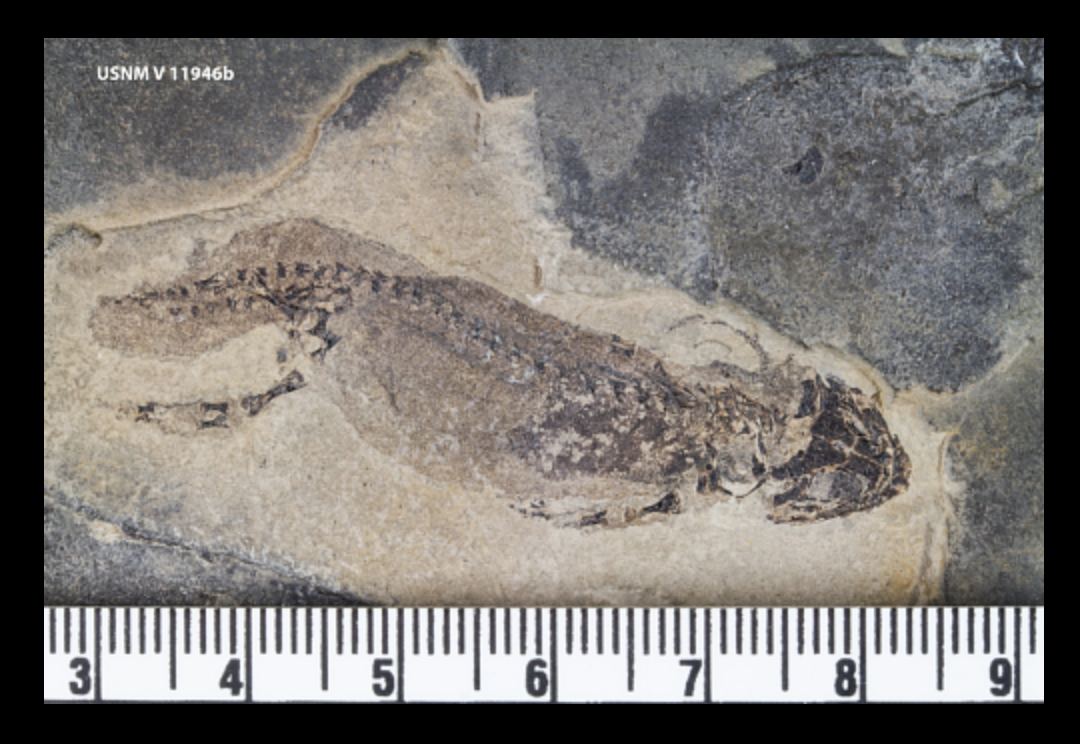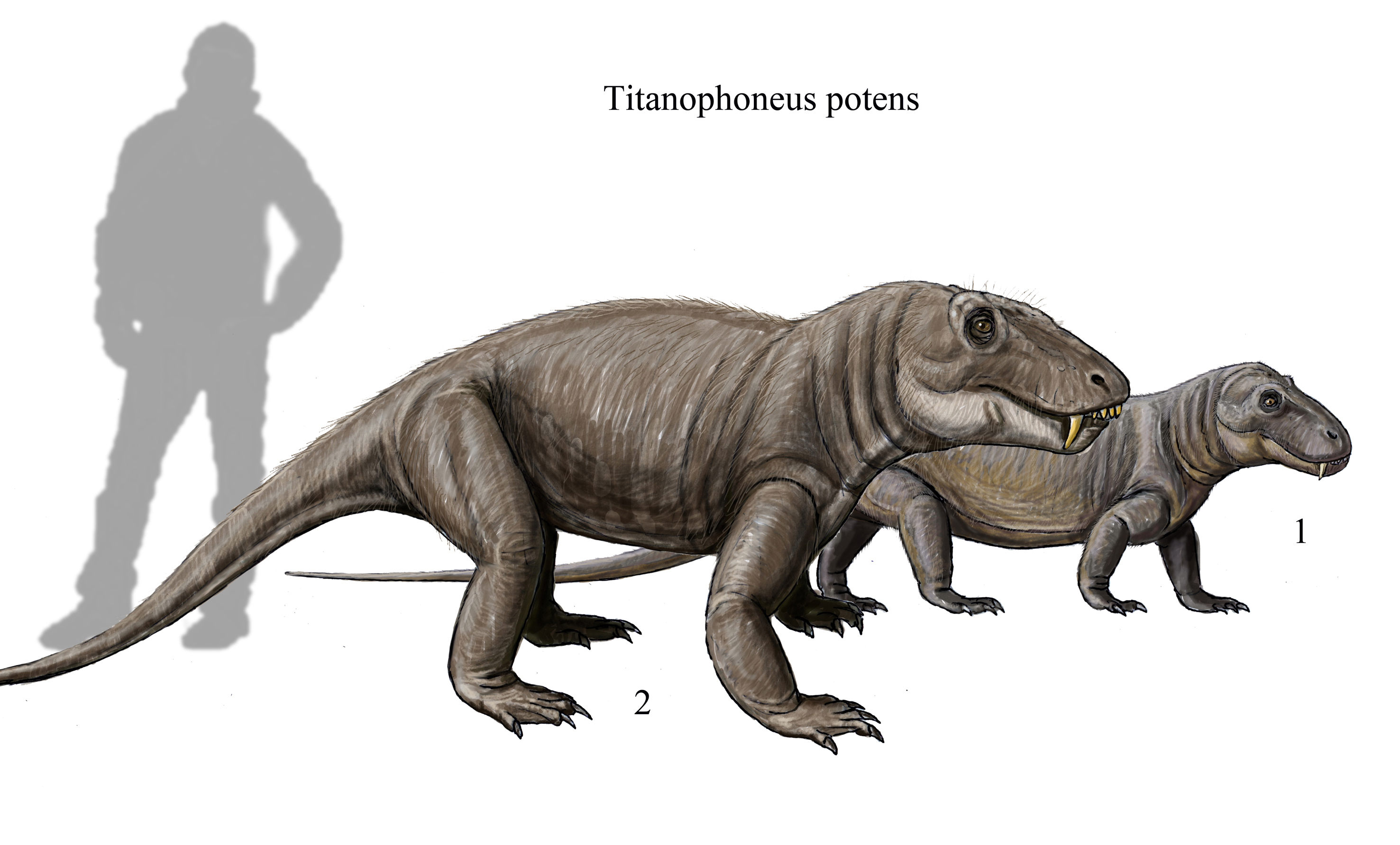|
Branchiosauridae
Branchiosauridae is an extinct family of small amphibamiform temnospondyls with external gills and an overall juvenile appearance. The family has been characterized by hundreds of well-preserved specimens from the Permo-Carboniferous of Middle Europe.Schoch, R.R. 2008. The intrarelationships and evolutionary history of the temnospondyl family branchiosauridae. Journal of Systematic Palaeontology. 6(4):409-431. Specimens represent well defined ontogenetic stages and thus the taxon has been described to display paedomorphy (perennibranchiate). However, more recent work has revealed branchiosaurid taxa that display metamorphosing trajectories.Schoch, R.R. and Frobisch, N.B. 2006. Alternative Pathways in an Extinct Amphibian Clade. Evolution. 60(7):1467-1475 The name Branchiosauridae (“Branchio” in Ancient Greek denoting gills and “saurus” meaning lizard) refers to the retention of gills. Geological/paleoenvironmental information Branchiosaurids mostly inhabited Permo-Ca ... [...More Info...] [...Related Items...] OR: [Wikipedia] [Google] [Baidu] |
Amphibamiform
Amphibamiformes is an unranked clade with Dissorophoidea created by Schoch (2018). It encompasses all of the taxa traditionally considered to be "Amphibamidae, amphibamids" (subsequently restricted to ''Doleserpeton, Doleserpeton annectens'' and ''Amphibamus, Amphibamus grandiceps'' by Schoch), Branchiosauridae, branchiosaurids, and hypothetically lissamphibians under the traditional temnospondyl hypothesis of Labyrinthodontia#Origin of modern amphibians, lissamphibian origins. These taxa are typically small-bodied dissorophoids and form the sister group to Olsoniformes, which comprises Dissorophidae, dissorophids and Trematopidae, trematopids. Description Amphibamiformes are diagnosed by a palatine and ectopterygoid reduced to narrow struts, a laterally-expanded interpterygoid vacuity, a humerus length-to-waist ratio of 6:10, and an absent basioccipital and supraoccipital. Definition A node-based clade; the most inclusive clade containing ''Amphibamus grandiceps'' but not '' ... [...More Info...] [...Related Items...] OR: [Wikipedia] [Google] [Baidu] |
Temnospondyl
Temnospondyli (from Greek language, Greek τέμνειν, ''temnein'' 'to cut' and σπόνδυλος, ''spondylos'' 'vertebra') or temnospondyls is a diverse ancient order (biology), order of small to giant tetrapods—often considered Labyrinthodontia, primitive amphibians—that flourished worldwide during the Carboniferous, Permian and Triassic periods, with fossils being found on every continent. A few species continued into the Jurassic and Early Cretaceous periods, but all had gone extinct by the Late Cretaceous. During about 210 million years of evolutionary history, they adapted to a wide range of habitats, including freshwater, terrestrial, and even coastal marine environments. Their life history is well understood, with fossils known from the larval stage, metamorphosis and maturity. Most temnospondyls were semiaquatic, although some were almost fully terrestrial, returning to the water only to breed. These temnospondyls were some of the first vertebrates fully adapted t ... [...More Info...] [...Related Items...] OR: [Wikipedia] [Google] [Baidu] |
Apateon
Apateon is an extinct genus of temnospondyl amphibian within the family (biology), family Branchiosauridae. Species *†''Apateon caducus'' *†''Apateon dracyi'' *†''Apateon flagrifer'' *†''Apateon kontheri'' *†''Apateon pedestris'' Christian Erich Hermann von Meyer, von Meyer 1840 *†''Apateon umbrosus'' Fossil record Fossils of ''Apateon '' are found in freshwaters strata of Latest Carboniferous (Gzhelian) to Early Permian (Asselian) of Germany. Description These amphibians could reach a length of about , while the length of the skull could reach . They resembled a salamander and had a laterally flattened tail with a long fin. The body was completely covered with rounded scales. The portion of the skull behind the eyes was quite short. On opposite sides of the head there are three pairs of long, spiral-shaped external gills. They had a weakly ossified skeleton and a wide, short skull, with huge eye holes. The teeth were small and peaked. On the hands are present fou ... [...More Info...] [...Related Items...] OR: [Wikipedia] [Google] [Baidu] |
Tungussogyrininae
''Tungussogyrinus'' is an extinct genus of temnospondyl amphibian in the family Branchiosauridae Branchiosauridae is an extinct family of small amphibamiform temnospondyls with external gills and an overall juvenile appearance. The family has been characterized by hundreds of well-preserved specimens from the Permo-Carboniferous of Middle .... It has been assigned to its own subfamily, Tungussogyrininae. References Branchiosaurids Permian temnospondyls Triassic temnospondyls Fossils of Russia Taxa named by Ivan Yefremov Fossil taxa described in 1939 Prehistoric amphibian genera {{temnospondyli-stub ... [...More Info...] [...Related Items...] OR: [Wikipedia] [Google] [Baidu] |
Sakmarian
In the geologic timescale, the Sakmarian is an age or stage of the Permian period. It is a subdivision of the Cisuralian Epoch or Series. The Sakmarian lasted between 293.52 and million years ago (Ma). It was preceded by the Asselian and followed by the Artinskian.; 2004: ''A Geologic Time Scale 2004'', Cambridge University Press Stratigraphy The Sakmarian Stage is named after the Sakmara River in the Ural Mountains, a tributary to the Ural River. The stage was introduced into scientific literature by Alexander Karpinsky in 1874. In Russian stratigraphy, it originally formed a substage of the Artinskian Stage. Currently, the ICS (International Commission on Stratigraphy) uses it as an independent stage in its international geologic timescale. The base of the Sakmarian Stage is defined by the first appearance of conodont species '' Streptognathodus postfusus'' in the fossil record. A global reference profile for the stage's base (a GSSP A Global Boundary Stratotype ... [...More Info...] [...Related Items...] OR: [Wikipedia] [Google] [Baidu] |
Wordian
In the geologic timescale, the Wordian is an age or stage of the Permian. It is the middle of three subdivisions of the Guadalupian Epoch or Series. The Wordian lasted between and million years ago (Ma). It was preceded by the Roadian and followed by the Capitanian. Stratigraphy The Wordian Stage was introduced into scientific literature by Johan August Udden in 1916 and was named after the Word Formation of the North American Permian Basin. The Wordian was first used as a stratigraphic subdivision of the Guadalupian in 1961, when both names were still only used regionally in the southern US. The stage was added to the internationally used ISC timescale in 2001.; 1999: ''Proposal of Guadalupian and Component Roadian, Wordian and Capitanian Stages as International Standards for the Middle Permian Series'', Permophiles 34: pp 3–11. The base of the Wordian Stage is defined as the place in the stratigraphic record where fossils of conodont species ''Jinogondolella aserrata'' ... [...More Info...] [...Related Items...] OR: [Wikipedia] [Google] [Baidu] |
Kaş Formation
Kaş () is a small fishing, diving, yachting and tourist town, and a municipality and district of Antalya Province, Turkey. Its area is 1,750 km2, and its population is 62,866 (2022). It is 168 km west of the city of Antalya. As a tourist resort, it is relatively unspoiled. History Although the Teke peninsula has been occupied since the Stone Age, it seems Kaş was founded by the Lycians, and its name in Lycian language was ''Habesos'' or ''Habesa''. It was a member of the Lycian League, and its importance during this time is confirmed by the presence of one of the richest Lycian necropoleis. In the Hellenistic period and under the Roman Empire it served as the port of Phellus called Antiphellus (), the name by which it was known at that time. The town suffered because of Arab incursions, then was annexed (under the name of ''Andifli'') to the Anatolian Sultanate of Rum, led by the Seljuks. After the demise of the Seljuks, it came under the Ottomans. In 1923, b ... [...More Info...] [...Related Items...] OR: [Wikipedia] [Google] [Baidu] |
Guadalupian
The Guadalupian is the second and middle Series (stratigraphy), series/Epoch (geology), epoch of the Permian. The Guadalupian was preceded by the Cisuralian and followed by the Lopingian. It is named after the Guadalupe Mountains of New Mexico and Texas, and dates between 272.95 ± 0.5 – 259.1 ± 0.4 Mya. The series saw the rise of the therapsids, a minor extinction event called Olson's Extinction and a significant Extinction event, mass extinction called the end-Capitanian extinction event. The Guadalupian is also known as the Middle Permian. Name and background The Guadalupian is the second and middle series or epoch of the Permian. Previously called Middle Permian, the name of this epoch is part of a revision of Permian stratigraphy for standard global correlation. The name "Guadalupian" was first proposed in the early 1900s, and approved by the International Subcommission on Permian Stratigraphy in 1996. References to the Middle Permian still exist. The Guadalupian was p ... [...More Info...] [...Related Items...] OR: [Wikipedia] [Google] [Baidu] |
Branchiosaurus Salamandroides
''Branchiosaurus'' (from , 'gill' and , 'lizard') is a genus of small, prehistoric amphibians. Fossils have been discovered in strata dating from the late Pennsylvanian (geology), Pennsylvanian Epoch to the Permian Period. The taxa may be invalid; the material referred to the genus may be juvenile specimens of larger amphibians. This tiny amphibian was very similar to the Rachitomi, differing primarily in size. Other distinguishing characteristics include a cartilaginous, less bone, ossified skeleton and a shorter skull. Clear traces of gills are present in many fossilized samples, hence the name. Originally thought to have vertebrae distinct from rhachitomous vertebrae, it was placed in a separate Scientific classification, order named Phyllospondyli ("leaf vertebrae"). Later analysis of growth stages showed increasing ossification in larger specimens, which showed that at least some of the species was the larval stage of much larger rachitomes like ''Eryops'', while others ... [...More Info...] [...Related Items...] OR: [Wikipedia] [Google] [Baidu] |
Lamination
Simulated flight (using image stack created by μCT scanning) through the length of a knitting needle that consists of laminated wooden layers: the layers can be differentiated by the change of direction of the wood's vessels Shattered windshield lamination keeps shards in place Laminate flooring A flexible thin-film solar cell for aerospace use (2007) Lamination is the technique/process of manufacturing a material in multiple layers, so that the composite material achieves improved strength, stability, sound insulation, appearance, or other properties from the use of the differing materials, such as plastic. A laminate is a layered object or material assembled using heat, pressure, welding, or adhesives. Various coating machines, machine presses and calendering equipment are used. Lamination may be applied to textiles, glass, wood, or other materials. Laminating paper in plastic makes it sturdy, waterproof, and erasable. Laminating metals and electronic components ma ... [...More Info...] [...Related Items...] OR: [Wikipedia] [Google] [Baidu] |
Gene Flow
In population genetics, gene flow (also known as migration and allele flow) is the transfer of genetic variation, genetic material from one population to another. If the rate of gene flow is high enough, then two populations will have equivalent allele frequencies and therefore can be considered a single effective population. It has been shown that it takes only "one migrant per generation" to prevent populations from diverging due to Genetic drift, drift. Populations can diverge due to Natural selection, selection even when they are exchanging alleles, if the selection pressure is strong enough. Gene flow is an important mechanism for transferring genetic diversity among populations. Migrants change the distribution of genetic diversity among populations, by modifying allele frequencies (the proportion of members carrying a particular variant of a gene). High rates of gene flow can reduce the genetic differentiation between the two groups, increasing homogeneity. Gene flow has b ... [...More Info...] [...Related Items...] OR: [Wikipedia] [Google] [Baidu] |




